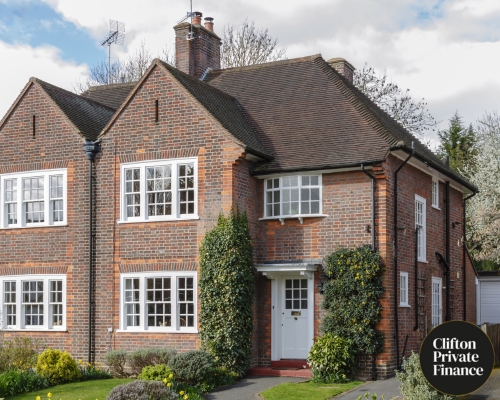Categories
Bridge to Let Loans: What You Need to Know

Bridge to let loans are flexible finance solutions for buy to let and investment properties. In many circumstances, they can empower you to act like a cash buyer if you are experiencing a short-term funding gap.
These loans are most commonly used when:
- You don't have the cash to hand and need funds to bridge the gap (perhaps you're waiting for another property to sell elsewhere)
- You're buying an investment property to renovate and flip for a profit (typically within 12-18 months)
- A standard mortgage will be too slow to arrange (for auction property purchases, for example)
- Or the property you're buying isn't suitable for a mortgage yet and needs refurbishments before refinancing on a BTL mortgage
Financing a property through a bridge to let loan can allow you the flexibility to fund a variety of buy to let properties – especially properties at auction or properties in an unmortgageable state.
Further down the line, you can take out a standard mortgage on the property to pay off your bridging loan and refinance or sell the property and realise your profits.
If you’re looking for a bridge to let loan, our finance brokers can assist through our loan service:
- Finance from £50,000 to £5 million
- Terms of finance between 1 month up to 3 years
- Fast Finance - 5 to 7 working days possible (in special cases)
- Interest can be rolled up to avoid monthly payments and protect cash flow
- Bridge to let loans for property conversions and refurbishments
Book a consultation below, or keep reading to learn in detail how bridge to let loans work.
Written by: Sam O'Neill & Sam Hodgson
See similar: How to improve your EPC rating: the landlord's guide

In this guide:
What is a bridge to let loan?
Bridge to let loans are a type of short-term finance. More specifically, landlords often use them to purchase or renovate a property, then refinance to a buy to let mortgage for rental income.
Essentially, it's a bridge loan with a specific function - letting property investors and landlords acquire property and renovate or convert it to improve their overall value and potential income once rented out.
After a property is financed through a bridge to let loan, a mortgage can be taken out against the property to replace the bridge to let loan.
Case Study: Read our case study below on how we helped a 75-year-old retiree secure funding to renovate a buy to let.
How Do Bridge to Let Loans Work?
A bridge to let loan application process works very similarly to other types of bridge loans:
-
You'll need to supply the necessary documentation, such as information on the property being purchased, your plans for renovating it, and any additional requirements from the lender.
-
A lender must conduct a valuation to determine whether the purchased property is of sufficient value or to estimate its potential value after refurbishments to satisfy the loan amount needed.
-
If the lender finds this sufficient and accepts your application, you can purchase your property and carry out any renovation plans.
-
If you convert to a buy to let mortgage once you have purchased the property, this can improve cash flow. Converting to a mortgage can reduce the overall cost of borrowing from the comparably expensive borrowing costs associated with bridge finance—i.e., high interest rates and additional fees.
It’s important to note that bridging loans are usually not offered by high-street lenders in the UK. If you’re looking for bridging finance, you may need to seek funding from a private lender.
Specialist bridging finance brokers have access to a network of private lenders and can get you the best deal for your circumstances.
With this in mind, it is best to consult with a broker before applying for a bridge to let loan to find the most favourable rates.
For more example uses and how bridging finance works, our most senior bridging advisor, Sam O'Neill, explains the process in the video below:
Are Bridge to Let Loans Secured or Unsecured?
Bridge to let loans are secured loans. They require the purchased property as collateral, meaning the property value backs up the borrowing amount.
- Your application relies on a solid exit strategy for this type of loan. This means to be accepted for the bridging loan, you need to have a sure-fire way that you will pay back full loan amount within the allotted timeframe, which is usually 12 months.
- For a bridge to let loan, a common exit strategy is refinancing to a buy to let mortgage. However, you could also sell another property to release funds to repay the bridging loan.
- A key advantage of bridging finance is its flexibility, so if you can prove you have a sure-fire way to pay back your bridge to let loan, you may be able to use this in your application.
However, in most cases, a bridge to let loan will cover the property purchase and the intended renovations, which can allow you to start generating the necessary income to apply for a buy to let mortgage.
Read blog: How to Get a Bridging Loan in Scotland
What Are Bridge to Let Loans Used For?
You can typically use bridge to let loans to purchase a property that requires renovation or refurbishment before it can be rented out.
A bridge to let loan can provide short-term finance to cover your property purchase, alongside any additional costs for necessary renovations before it can be rented out as a buy to let.
Here are a few common scenarios in which a bridge to let loan can be suitable:
- Unmortgageable properties – If a property doesn’t have the proper facilities or infrastructure to be in a liveable state, it is considered unmortgageable. For instance, if a property is derelict or doesn’t have a kitchen or bathroom, then it won’t be eligible for a mortgage.
- Auction properties – A bridge to let loan may be used to acquire a property at auction, where it is a requirement that a purchase must be completed within a short period of 28 days. Additionally, some auction properties can also be in an unmortgageable state. In this scenario, the benefit of a bridge to let loan is that it can allow you to access funds more quickly than with a long-term loan like a mortgage.
- Investment opportunities – If you’ve come across a lucrative investment opportunity, you may need to act quickly, and with more flexibility than the strict criteria of a mortgage can allow. Bridging finance can be a suitable option in this respect. It provides flexibility and can sometimes be processed as quickly as 5 - 7 days, allowing you to beat any competition to the punch.

How Much Can You Borrow With a Bridge to Let Loan?
There are no real upper limits to borrowing when it comes to a bridge to let loan – they can range from £50,000 to £5M if required.
- However, your borrowing potential could depend on a number of factors, mainly the value of the property you are going to purchase. You must also have met all the necessary criteria set by the lender for the loan amount you need.
- With bridge to let loans and bridging finance in general, there are a number of additional costs to contend with – such as valuation fees, higher interest rates and set-up fees, which can inflate the overall cost of a bridge to let loan.
- That being said, there are occasions where a bridging loan can be set up to be more affordable than specific mortgage deals. For many borrowers looking to access funds quickly and conveniently, these extra expenses are worthwhile in securing the property they want.
Bridging Loan Calculator
To get an idea of how much a bridging loan is going to cost you, use our bridging loan calculator:

How We Can Help
At Clifton Private Finance, we can facilitate a bridge to let loans via several specialist lenders across the entire short-term market. These lenders are not typically available through the retail market.
We provide:
- Expert advice on bridge to let finance for landlords and investors
- Finance for converting a property into multiple units (HMOs)
- Fast finance for auction purchases
- Specialist refurbishment and renovation products available
- Help in arranging a buy to let mortgage exit for the bridging loan
- Short and long-term lending options
- Professional service
There’s no shortcut to detailed market knowledge and a solid understanding of how the structure of bridging finance can suit individual circumstances.
At Clifton Private Finance, our team of expert bridging loan brokers is on hand to discuss your situation and help you decide if a bridging loan is the right solution for you.
Call us on 0117 313 5126 to discuss your requirements or book a consultation below.


FAQs
Yes, a valuation is typically required for a bridging loan in the UK. Since bridging loans are often secured against a property or other valuable assets, lenders will want to assess the market value of the property being used as security. This helps the lender determine how much deposit they want you to provide based on the value and condition of the property. You can borrow up to £25m with bridging finance, but it’s typically capped at about 80% of the value of the property you’re using as security. It's important to note that different lenders have varying policies and criteria regarding the maximum loan amounts they offer for bridging finance. Some lenders have a maximum limit of over £1 million, while others may specialize in smaller loan amounts. Additionally, the terms and conditions of the loan, including interest rates and fees, should also be taken into consideration when determining the overall affordability of the bridging loan. Yes, you typically need a 20-40% deposit for a bridging loan. It can be possible to get a bridging loan without a deposit (a 100% bridging loan), but you’ll need other assets in the background to secure the loan against, and more stringent criteria and higher costs could apply. Yes, it is possible to get a 100% bridging loan (also known as a 100% LTV bridging loan), but it is rare. This means that you won’t need to put down a deposit and can borrow the full value of your property. However, the criteria for these loans can be hard to meet, and you’ll need to provide additional assets as security for your loan. Interest rates and fees can also be higher to compensate. While using bridging finance doesn’t technically make you a cash-buyer, it can allow you to act like one. Mortgages take months to process, often leading to an ‘onward chain’ where all parties involved need to wait for funds to be transferred. Bridging finance can usually be accessed a lot quicker than mortgages so you can bypass the onward chain, giving you an advantage over other buyers and being attractive to sellers. Bridging loans typically have a term of 12 months, but some lenders are willing to stretch their terms to 18 months, or even 2 –3 years depending on the case. Terms longer than 2 years will usually only be considered for specific cases. Yes, you can use a bridging loan to pay Stamp Duty. This amount could be covered by a bridging loan, providing you have a way to repay the additional borrowing amount to your lender. Yes, bridging loans are safe when they’re used in the right circumstances with a solid repayment strategy. However, we recommend speaking to a qualified advisor, like our brokers at Clifton Private Finance, before you take out a product. The main factors to consider with bridging finance are that the full loan amount will usually need to be repaid within a year, and like a mortgage, it is secured against a property as collateral. This means that in the case that you aren’t able to repay your bridging loan, your property would be at risk of repossession. But with a watertight exit strategy, bridging finance can be an efficient way to secure property quickly. Bridging loans are designed to be short-term so there’s no maximum age limit when applying for a bridging loan. This does depend on the lender, as some bridging lenders do have an upper age limit, but there are lenders on the market who offer bridging loans for borrowers aged 70 and over. Bridging loan interest rates usually range between 0.45% - 2% per month, depending on the case and the market rate. Unlike mortgage interest rates, bridging loan interest is calculated monthly instead of yearly. This is because bridging loans are short-term and, in many cases, repaid within a year. Bridging loans can be arranged without early repayment penalties, so interest is calculated monthly to ensure you only pay interest on the months you have the loan for. Unfortunately, mainstream banks in the UK don’t offer bridging loans. This means that if you’re looking for a bridging loan, you won’t be able to get one using a lender you’d find on the high street. There are a variety of specialist lenders that offer bridging loans, but because these lenders are smaller and more niche, you may need a bridging broker to access them. Banks typically charge two main fees when taking out a bridging loan – arrangement fees and interest. But there are other costs to consider such as valuation fees, broker fees and administration fees. Costs can vary from lender to lender, and will also depend on what your bridging loan is for (e.g., residential or commercial purposes.) Arrangement fees are what the lender charges you to take out the loan and can range between 1.5 - 3% of your overall loan. Bridging loan interest, on the other hand, is calculated monthly. This can catch borrowers out who may be expecting an Annual Percentage Rate (APR) like with a mortgage. Yes, you can convert a bridging loan to a mortgage through refinancing, and it is common among borrowers who use bridging finance to buy residential properties. However, whether or not you’ll be able to refinance to a mortgage is dependent on your financial circumstances, the lender, and the property you’re planning to buy. It’s important to be sure that refinancing is a viable repayment option before you take out a bridging loan on a residential property. Yes, bridging loans are typically more expensive than mortgages. Bridging loan interest rates can be much higher than a mortgage, and are calculated and displayed as monthly rates instead of the usual annual percentage rate (APR) that you’ll see on a mortgage. However, bridging loans are a short-term solution, and you’ll only pay interest on the months you’ve borrowed money for – and you can repay early without any charges (for most loans). There are many circumstances where bridging loans are an affordable option and a means to an end - for borrowers that need to finance a property purchase quickly, it may be the only option available. The two most common ways to pay a bridging loan are to sell a property or refinance to a mortgage. You may also need to ‘service’ the loan through the term, which means paying the interest monthly. However, you can opt to ‘roll up’ your bridging interest to be repaid at the end along with the capital. There are also other ways to repay a bridging loan, such as selling a business or even using money from an inheritance. The method in which you pay your bridging loan can be flexible, just as long as it is clear in your application that you have a surefire way to repay your loan when the terms are up. In most cases, a bridging loan will require a minimum deposit of 25%. However, the minimum can vary depending on the lender and the specific circumstances of the loan itself. Generally, bridging loans are secured against a property or other valuable assets, and the deposit required is often expressed as a percentage of the property's value, known as the loan-to-value ratio. In some cases, 0% deposit bridging loans are an option, but only if you have other property or assets in the background to provide additional security. No, typically, you’ll repay a bridging loan in one chunk at the end of the loan term. Bridging loans are a form of short-term finance and will usually need to be repaid within 12 months, but there can be room for flexibility. In some cases, borrowers may be required to make monthly interest payments. This means that each month, you would pay the interest accrued on the loan amount while the principal amount remains outstanding until the end of the loan term. But usually, the interest is "rolled up" or added to the loan balance and paid with the rest of the loan at the end of the term. This option can help protect your cashflow so you can spend it on moving costs or refurbishments, for example. Bridging loans can be arranged in as little as 7 working days. However, it depends on the complexity of the bridge loan and your specific circumstances. It may also be more expensive for you to rush an urgent application through – but not impossible. Bridging loans are a popular option for borrowers who are under time constraints, such as buying a property at auction or breaking a chain. The key factors lenders tend to consider are: Security - Bridging finance is usually secured against property or other valuable assets. Lenders will assess the value and marketability of your security. Exit Strategy - Lenders will want to understand how you plan to repay your bridging loan. In most cases, this is selling your old property, selling the new property (flipping), or refinancing with a long-term mortgage. Loan-to-Value (LTV) Ratio - Lenders consider the loan amount compared to the value of the property being used as security as a percentage. The LTV ratio can vary, but most lenders will have a maximum of 60-80% LTV. Remember, the criteria for obtaining bridging finance in the UK can vary depending on the lender and your circumstances.
Do you need a valuation for a bridging loan?
How much can you borrow with bridging finance?
Do you need a deposit for a bridging loan?
Can I get 100% bridging finance?
Does a bridging loan make you a cash buyer?
What is the longest bridging loan term?
Can I use a bridging loan to pay stamp duty?
Are bridging loans safe?
Can an 80 year old get a bridging loan?
What is the monthly interest rate on a bridging loan?
Do banks still do bridging loans?
How much do banks charge for bridging loans?
Can you turn a bridging loan into a mortgage?
Is a bridging loan more expensive than a mortgage?
How are bridging loans paid?
What is the minimum deposit for a bridging loan?
Do you pay monthly payments on a bridging loan?
How long does it take for a bridging loan to come through?
What is the criteria for bridging finance?










.png)

